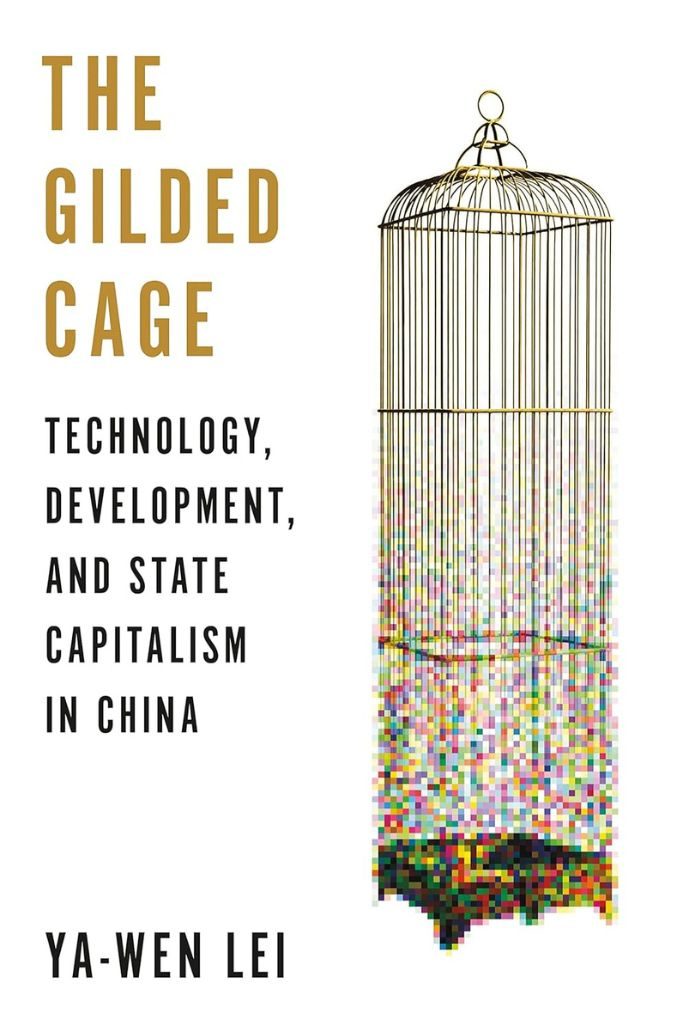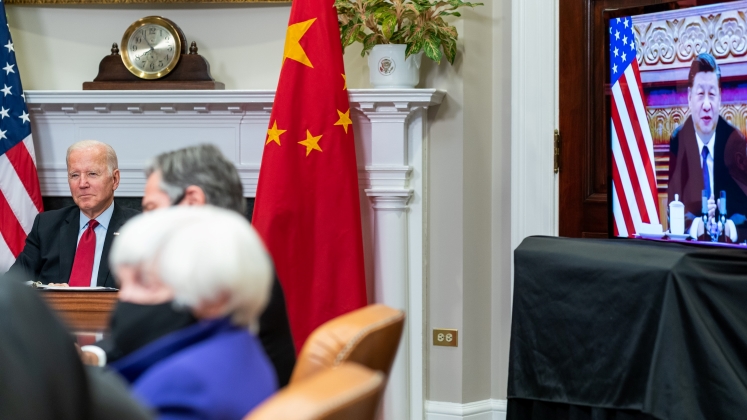In The Gilded Cage: Technology, Development, and State Capitalism in China, Ya-Wen Lei explores how China has reshaped its economy and society in recent decades, from the era of Chen Yun to the leadership of Xi Jinping. Lei’s meticulous analysis illuminates how China’s blend of marketisation and authoritarianism has engendered a unique techno-developmental capitalism, writes George Hong Jiang.
 Twenty years ago, people inside and outside China were wondering whether the country would eventually capitulate to dominant capitalist and democratic models. American politicians such as Bill Clinton were enthusiastically looking forward to the future integration of China into globalisation. When this happened, millions of ordinary people would get rich and become the middle class through fast-growing international trade and domestic labour-intensive industries. However, this judgment quickly proved ill-made. China has simultaneously emulated the US in high-tech industries but also become an unparalleled authoritarian state which polices its citizens through intellectual technology and high-tech instruments. How has it achieved this, and what are the effects of this? Lei tries to untangle these questions in her book, The Gilded Cage: Technology, Development, and State Capitalism in China.
Twenty years ago, people inside and outside China were wondering whether the country would eventually capitulate to dominant capitalist and democratic models. American politicians such as Bill Clinton were enthusiastically looking forward to the future integration of China into globalisation. When this happened, millions of ordinary people would get rich and become the middle class through fast-growing international trade and domestic labour-intensive industries. However, this judgment quickly proved ill-made. China has simultaneously emulated the US in high-tech industries but also become an unparalleled authoritarian state which polices its citizens through intellectual technology and high-tech instruments. How has it achieved this, and what are the effects of this? Lei tries to untangle these questions in her book, The Gilded Cage: Technology, Development, and State Capitalism in China.
The author was inspired by the “birdcage economy” of Chen Yun when choosing the title of the book.[…] Statist control is the cage, and private economies, like captive birds, are only allowed to fly within the cage.
The author was inspired by the “birdcage economy” of Chen Yun when choosing the title of the book (5). Building the planned economy in the early 1950s and supporting economic reforms in the 1980s, Chen Yun was one of the most important architects of economic systems in communist China. While he was a proponent of giving more space to private economies, Chen Yun staunchly believed in the efficacy of governmental regulations. Statist control is the cage, and private economies, like captive birds, are only allowed to fly within the cage. Chen Yun was particularly cautious about liberalist reforms, such as deregulation of finance and fiscal decentralisation, and distinctly opposed to privatisation. After he died in 1995, Deng Xiaoping and his disciples, including Jiang Zemin and Hu Jintao, carried out deregulation bravely until the late 2000s. But the ideal of Chen Yun’s “birdcage economy” is never abandoned by communists who fear losing control over the society.
The 2008 financial crisis started China’s big turn of macroeconomic policies. In order to stimulate the deflated economy, the government reacted fast and invested enormous capital into a few key strategic industries, including bio-manufacturing industry and aircraft and electronic manufacturing. Ling & Naughton (2016) believe that this action signalled the watershed of China’s economic orientation. The government’s budget poured into these industries, and bureaucratic units responsible for supervision and regulation turned to interventionist policies. The trend was further strengthened after Xi Jinping, who believes that the combination of the free market economy and Leninist political principles is the best blueprint for China, ascended to the presidency in 2012.
New leadership since the 2010s wants to emulate western high-end development rather than provide low-end, cheap and labour-intensive products for the West.
The ambition to develop high-tech industries runs in tandem with the unique political system of China. Economic growth has helped sustain political legitimacy of the Chinese Communist Party (CCP) since the 1980s. Since socialism was smeared by the Cultural Revolution (1966-1976) and its disastrous economic consequences, economic growth has been identified as the most important source of political legitimacy. Economic performance has become the indicator of bureaucratic promotion, which has fused China’s politics and economies together. This political organisational mechanism makes it easier for leaders to push through any desired change and it is on this that China’s turn to techno-development (Chapter Three) is precisely based. New leadership since the 2010s wants to emulate western high-end development rather than provide low-end, cheap and labour-intensive products for the West.
Still, a key question must be answered: why are Chinese bureaucrats who care primarily about social stability and political monopoly willing to replace human labour with robots, which tends to reduce employment in the short run? In Chapter Five, the author traces the process of robotisation in firms which previously rely on cheap labour, including Foxconn. While the benefits of robotisation might be obvious to entrepreneurs aspiring to reduce costs by any means, potential instability could cause trouble for communist bureaucrats. The answer lies in the possibility that technological upgrades will lead to an enlarging economy capable of digesting more workers than it kicks out. However, it results in a dilemma: if the growth rate slows down, the appetite for mechanisation and robotisation could stir social tensions.
Seeing the chance to surpass the West in the development of high-tech industries, the Chinese Communist Party (CCP) is more than willing to strengthen control over public spheres and civil society and increase investment in the sector to achieve this.
Seeing the chance to surpass the West in the development of high-tech industries, the Chinese Communist Party (CCP) is more than willing to strengthen control over public spheres and civil society and increase investment in the sector to achieve this. As the author puts it, “the Chinese state is an unwavering believer in intellectual technology and instrumental power and employs both to enhance governance and the economy” (9). It is highly possible that with the help of an authoritarian regime and its will to develop technological capability, the dismal future that Max Weber once predicted – ie, the “iron cage of bureaucracy” in which depersonalised and ossified instrumental rationality will dominate every sphere in the society – will come sooner in China than in the West.
Economic growth is mainly driven by high-tech industries that private and state-owned capital foster, both of which must be under the control of the government, with the unified aim of rejuvenating the Chinese nation.
Karl Marx argued that productive power, including technological conditions, determines relations of production. This idea is being justified in China. A mix between marketised economies and authoritarian rule, which is penetrated by high-tech instruments, facilitate the rise of techno-developmental capitalism, as the author proposes in Chapter Nine. On the one hand, large tech companies in China have hatched one of the biggest markets in the world. On the other hand, tech professionals’ increasing demand for institutional (if not political) reforms (Chapter Eight) renders bureaucrats gradually more concerned about their social influence. For instance, Jack Ma, the boss of Alibaba, attacked the state-owned financial system and instantly got punished by the authority. China is developing a new variant of capitalism: economic growth is mainly driven by high-tech industries that private and state-owned capital foster, both of which must be under the control of the government, with the unified aim of rejuvenating the Chinese nation.
Techno-developmental capitalism is not the result of contingency, but path-dependent outcome, the direct result of China’s polities.
The author includes an excellent range of relevant materials into the book, spanning academic literature and personal interviews with private entrepreneurs and IT practitioners. Lei also bravely applies the term “instrumental rationality” in relation to China’s socioeconomic reality. In so doing she identifies the Janus-faced nature of China’s technological development, whereby the society enjoys higher productivity but becomes more rigid and occluded due to the omnipotent techno-bureaucracy. Nonetheless, the book could have been improved if Lei could take China’s political-economic structure into account when explaining the motivation to develop high-tech industries. While Lei focuses on the era after the 2000s, the rise of techno-developmental capitalism is deeply rooted in the persistent logic of the CCP since the late 1970s. In other words, techno-developmental capitalism is not the result of contingency, but a path-dependent outcome, the direct result of China’s polity. In spite of this lack of fully examined historical dimensions, Lei presents a good guidebook for China’s holistic development, not just within the last two decades but also in the decades to come.
Note: This post gives the views of the author, and not the position of the LSE Review of Books blog, or of the London School of Economics and Political Science.
Image credit: B.Zhou on Shutterstock.








1 Comments